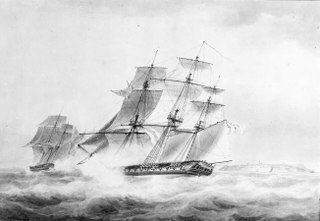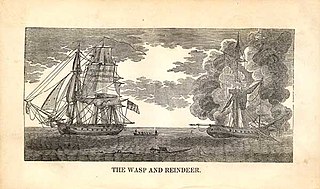
HMS Clio was a Cruizer-class brig-sloop of the Royal Navy, launched at James Betts' shipyard in Mistleythorn in Essex on 10 January 1807. Her establishment was 71 officers and men, 24 boys and 20 marines. She served in the Baltic during the Napoleonic Wars, accomplished the re-establishment of British rule on the Falkland Islands in 1833, and participated in the First Opium War. She was broken up in 1845.

HMS Phoenix was a 36-gun Perseverance-class fifth-rate frigate of the Royal Navy. The shipbuilder George Parsons built her at Bursledon and launched her on 15 July 1783. She served in the French Revolutionary and Napoleonic Wars and was instrumental in the events leading up to the battle of Trafalgar. Phoenix was involved in several single-ship actions, the most notable occurring on 10 August 1805 when she captured the French frigate Didon, which was more heavily armed than her. She was wrecked, without loss of life, off Smyrna in 1816.

HMS Reindeer was a Royal Navy 18-gun Cruizer-class brig-sloop of the Royal Navy, built by Samuel & Daniel Brent at Rotherhithe and was launched in 1804. She was built of fir, which made for more rapid construction at the expense of durability. Reindeer fought in the Napoleonic Wars before succumbing in 1814 to the guns of USS Wasp during the War of 1812.

The Cherokee class was a class of brig-sloops of the Royal Navy, mounting ten guns. Brig-sloops were sloops-of-war with two masts rather than the three masts of ship sloops. Orders for 115 vessels were placed, including five which were cancelled and six for which the orders were replaced by ones for equivalent steam-powered paddle vessels.
Four ships of the Royal Navy have borne the name HMS Cordelia, named after the legendary Queen of the Britons:

The Cruizer class was an 18-gun class of brig-sloops of the Royal Navy. Brig-sloops were the same as ship-sloops except for their rigging. A ship-sloop was rigged with three masts whereas a brig-sloop was rigged as a brig with only a fore mast and a main mast.

HMS Blossom was an 18-gun Cormorant-class sloop-of-war. She was built in 1806 and is best known for the 1825–1828 expedition under Captain Beechey to the Pacific Ocean. She explored as far north as Point Barrow, Alaska, the furthest point into the Arctic any non-Inuit had been at the time. She was finally broken up in 1848.
HMS Electra was a 16-gun brig-sloop. She was built by the Enterprise Ethéart, Saint-Malo, as the French Curieux-class brig Espiègle and launched in 1804. She was armed in 1807 at Saint Servan. The British frigate Sybille captured her on 16 August 1808. There was already an Espiegle in the Royal Navy so the Navy took the vessel they had just captured into service as HMS Electra, her predecessor Electra having been wrecked in March. Electra captured one American privateer before she was sold in 1816.

HMS Magnet was a Cruizer-class brig-sloop built at Robert Guillaume’s yard at Northam and launched in 1807. She served in the Baltic, where she took two prizes, one an armed privateer, before wrecking in 1809.

HMS Salsette was a Perseverance-class fifth-rate frigate of a nominal 36 guns, launched in 1805. The East India Company built her for the Royal Navy at the company's dockyards in Bombay. She was the Navy's first teak-built ship.
Ten ships of the Royal Navy have borne the name HMS Renard, or HMS Reynard, after the French for fox, and the anthropomorphic figure of Reynard:
HMS Patriot was a Dutch schuyt that the Royal Navy captured in 1808 and took into service. She captured several enemy vessels before she was converted to a water vessel in 1813. The Admiralty sold her in 1815.

HMS Childers was a brig-sloop of the British Royal Navy, initially armed with 10 carriage guns which were later increased to 14 guns. The first brig-sloop to be built for the Navy, she was ordered from a commercial builder during the early years of the American War of Independence, and went on to support operations in the English Channel and the Caribbean. Laid up for a time after the end of the American War of Independence, she returned to service shortly before the outbreak of the French Revolutionary Wars. She had an active career in both the French Revolutionary and Napoleonic Wars, capturing numerous French privateers and during the Gunboat War participated in a noteworthy single-ship action. The navy withdrew her from service at the beginning of 1811, at which time she was broken up.
HMS Constant was an Archer–class gun-brig of the Royal Navy, launched in 1801 for service against the French during the French Revolutionary and Napoleonic Wars. She was variously stationed in English home waters, the Baltic, the Caribbean, and off the coast of Spain, and was responsible for the capture of at least seven enemy vessels during her fifteen years at sea. The Royal Navy sold Constant at Chatham Dockyard in 1816.

HMS Rosario was a 20-gun sixth rate of the British Royal Navy. She was previously the French privateer Hardi, which HMS Anson captured in 1800. The navy took her into service as HMS Hardi but renamed her HMS Rosario later in 1800. She was sold in 1809.
HMS Cherokee was the lead ship of her class of 10-gun brig-sloops of the British Royal Navy. She saw service during the Napoleonic Wars. In 1810 she participated in an engagement that resulted in her crew qualifying for the Naval General Service Medal. The Navy sold Cherokee in 1828. She then became a merchantman trading between Liverpool and Africa. Cherokee was wrecked in August 1831 returning to England from Africa.
Several Royal Navy ships have borne the name HMS Cherokee:
HMS Redpole was a sailing brig of the Royal Navy, launched in July 1808. She was 238 52⁄94(tons bm), armed with eight 18-pounder carronades and two 6-pound bow chasers, and carried a crew of 75. One of the notorious Cherokee class, dubbed 'coffin brigs' because of the large numbers that were wrecked or foundered, she was sunk in action in August 1828 but prior to that played an active part in the Napoleonic Wars.
HMS Rinaldo was a Cherokee-class brig-sloop of the Royal Navy that was launched in July 1808. She was 236 66⁄94(bm), armed with eight 18-pounder carronades and two 6-pound bow chasers, and carried a crew of 75.









